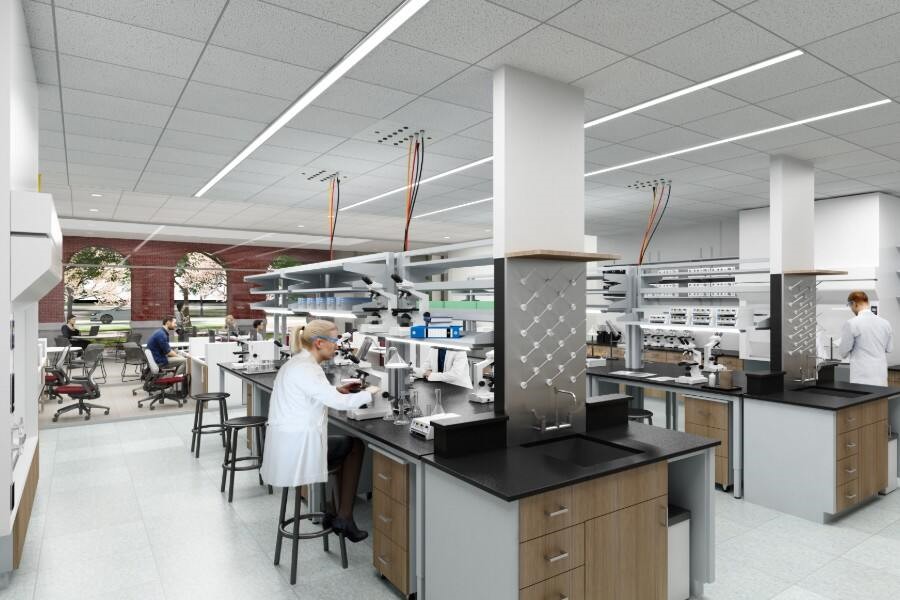Requirements for Shared Lab Spaces

Shared lab spaces can present unique challenges when it comes to lab safety. EH&S has created the following guidance to help Principal Investigators navigate these challenges.
Waste Disposal
- To ensure timely radioactive and chemical waste removal, schedule pick up immediately when containers are full
- Biohazardous waste containers should be removed at 1/2 to 3/4 full and autoclaved
- Sharps containers should be closed at 2/3 to 3/4 full and a medical & biological waste pickup request submitted to EH&S
- Each chemical waste container must be labeled with all contents or have an associated inventory sheet of its contents; do not use abbreviations. Submit a chemical waste pickup request.
- Secondary containment of liquid waste containers is even more important in a shared lab; it prevents accidents from happening!
- Do not share chemical waste containers with other lab groups, as dangerous unexpected chemical reactions could occur.
Labeling
- Label all hazardous material and equipment. Use warning signs to designate particular hazards.
- TWU’s Chemical Hygiene Plan requires that all lab members understand the labeling practices used in the lab
- Labels should be descriptive enough that EH&S and emergency responders can determine a chemical in event of an emergency where lab members are not present
Safe Work Practices
- Storage of items should leave at least 18 inches of clearance from the ceiling
- Fume hoods shall not be used to store chemicals
- Organize with your neighbors into floor groups and meet regularly to discuss safety expectations in the shared space and any concerns
- Take the opportunity to discuss other important concerns, such as housekeeping expectations, lab staffing schedules, and protocols for sharing chemicals and equipment
- Reference the Shared Lab Space Suitemate Agreement Discussion Topics document for talking points
- Open collaborative lab spaces require vigilant and continually improving work practices; consider your laboratory neighbors in all aspects of your work
- Cross-contamination risks are greater in a shared lab space; use care in performing experiments
- Notify collaborators of routine maintenance on shared equipment and potential problems from any laboratory devices
- Always practice good housekeeping and universal precautions
- Good housekeeping is respectful to your fellow suitemates and can prevent safety issues
- Universal precautions include wearing appropriate PPE even when you think it may not be necessary; do not take any unnecessary risks. Safety first!
- If you have a question as it relates to safety, please do not hesitate to contact EH&S as a resource for practicing safe science
Emergency Response
- Do not block aisles, hallways, and exit routes; placement of small portable file cabinets and mobile carts in these areas is prohibited
- Know the location of your eyewash and safety shower before you need to use them; keep these areas clear and unobstructed
- Set a schedule to test eyewash stations weekly
- Personnel from the Chemistry Department and/or Risk Management will be responsible for testing safety showers regularly
- Notify neighbors immediately in the event of a spill; ask for help from your immediate neighbors and have a communication plan for emergencies
- Notify neighboring groups that you are conducting experiments using hazardous materials; consider the worst possible scenario and have a plan for when things go wrong
Each PI is responsible for ensuring they have access to a well-stocked spill kit. This can be accomplished by either each individual PI maintaining a spill kit OR though utilizing a shared-lab spill kit. If utilizing a shared-lab spill kit, a protocol must be in place to inspect the kit monthly and to ensure the kit is re-stocked after each use.
Training
PIs are responsible for ensuring their lab members have completed all applicable training, the majority of which can be found on TWU's employee learning management site, Bridge. Training includes:
- Hazard Communication Training
- Hazardous Waste Training
- Laboratory Safety Training and all applicable modules. These modules must be taken if the hazard is present in the lab space, even if the lab user does not work with these hazards directly. They include:
- Vacuum and Pressure Operations
- Compressed Gases
- Heating Operations
- Cryogenics and Cooling Operations
- Particularly Hazardous Substances
- Bloodborne Pathogens Training** (if working with blood or other potentially infectious material (OPIM)
- Fire Safety and Evacuation Training (if employed by TWU)
- Stormwater Pollution Prevention Training (if employed by TWU)
- CITI Biosafety Training OR BSL-2 Awareness Training (if applicable)
- All SRC labs on the 2nd and 3rd floors are designated as BSL-2. If lab users do not work with biohazardous agents directly (i.e., have CITI Biosafety training) then they must complete the Risk Management BSL-2 Awareness training.
**If a PI’s lab users, which are employed by the university, work with blood or OPIM (e.g., Graduate Assistants), they must ensure that these lab users have been offered a Hepatitis B vaccine within 10 days of employment. If lab users are volunteers, they must provide documentation of their vaccination to the department before working with these materials. The PI must ensure that this documentation has been submitted.
Page last updated 10:34 AM, May 22, 2023